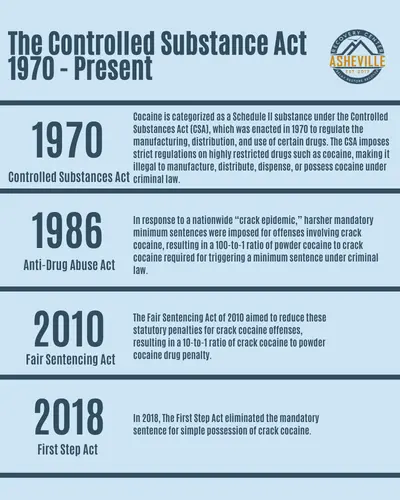People tend to think of crack and cocaine as two very different drugs. After all, one is a white, powdery substance that you snort; the other is a dark and sticky substance that you smoke. But in reality, they’re actually quite similar. Both substances are variations of the same chemical — cocaine.
However, there are some major differences between crack and cocaine that have implications for their effects on the user. As with many drug-related topics, the information about crack vs. cocaine comes from a variety of sources and has been misinterpreted in many cases.
Crack cocaine is considered more addictive than powdered cocaine due to its high potency that develops as a result of the method of production.
What is Cocaine?
Cocaine is a powerful stimulant drug made from the leaves of the coca plant, which is primarily found in South America. It is typically used recreationally for its intense stimulating effects and sense of euphoria. The drug exists in two forms: powder cocaine, also known as “coke” or “snow”, and crack cocaine. Powder cocaine is the hydrochloride salt form of the drug and can be consumed in a variety of ways such as snorting, injecting, or dissolving into water and drinking it.
What is Crack?
Crack, also known as “rock” or “cocaine” in some countries, is a solid, processed form of cocaine that is more potent and dangerous than powdered cocaine. It is commonly smoked in a glass or water pipe or injected intravenously. To make crack from cocaine hydrochloride, the drug is dissolved in water and ammonia, and then the solution is left to evaporate.
The resulting crystals are collected and dried into a solid form. Crack is created by dissolving powdered cocaine in a solvent such as sodium bicarbonate (baking soda) or sodium carbonate, and then extracting the resulting “rock” from the mixture.
How is Crack Made?
The process of making crack from powdered cocaine is very similar to what happens when baking. Baking soda (or sodium bicarbonate) and water are combined to make a dough, which is then baked into crack cocaine.
However, crack is cooked at a lower temperature than you’d use for cookies. The acid in the baking soda destroys some of cocaine’s carbon atoms, making them easier to separate from the rest of the mixture. Then, the water helps the remaining atoms link up with each other to form crystals. The finished product is a substance that resembles a fine, white sand.
The Effects of Crack and Cocaine
Crack cocaine and powdered cocaine produce the same effects. These include euphoria, alertness, a heightened mood, and increased energy. The effects of crack are felt immediately and last between 15 and 30 minutes, followed by a crash that leaves the user depressed and exhausted. The major difference between crack and powdered cocaine is the rate of absorption into the bloodstream.
The powder form is mixed with water and is generally consumed orally, resulting in a slower absorption rate. The crack form is inhaled, and the effects are felt immediately. People who are new to crack often experience stronger psychological effects than those who are experienced with cocaine. Users often report feelings of irritability, restlessness, and anxiety. These symptoms are usually caused by the sudden and intense release of dopamine in the brain.
Why is Crack More Dangerous Than Cocaine?
The crack form of cocaine has a higher potency than the powder form. The amount of powder cocaine required to make one gram of crack is just 8% of what it would take to make one gram of powder. This means that the same amount of crack will produce a much more intense, powerful high than the same amount of powdered cocaine.
The added danger of crack is the method of consumption. Because it is inhaled through the lungs, crack enters the bloodstream through the alveoli (air sacs) in the lungs. It takes just 6 to 8 seconds for the crack to reach the bloodstream from the lungs. When consumed as powder, cocaine is metabolized by enzymes in the gastrointestinal tract before it can reach the blood.
Crack & Cocaine In America
Although cocaine is still used legally for medicinal purposes, its highly addictive nature limits its use as an anesthetic and it is mostly used illicitly nowadays. Cocaine is categorized as a Schedule II substance under the Controlled Substances Act (CSA), which was enacted in 1970 to regulate the manufacturing, distribution, and use of certain drugs. The CSA imposes strict regulations on highly restricted drugs such as cocaine, making it illegal to manufacture, distribute, dispense, or possess cocaine under criminal law.
Initially, the CSA didn’t differentiate between cocaine and crack cocaine. However, in 1986, in response to a nationwide “crack epidemic,” harsher mandatory minimum sentences were imposed for offenses involving crack cocaine, resulting in a 100-to-1 ratio of powder cocaine to crack cocaine required for triggering a minimum sentence under criminal law.
The Fair Sentencing Act of 2010 aimed to reduce these statutory penalties for crack cocaine offenses, resulting in a 10-to-1 ratio of crack cocaine to powder cocaine drug penalty.
In 2018, The First Step Act eliminated the mandatory sentence for simple possession of crack cocaine.

How Is Cocaine Different From Crack?
The process of making crack from cocaine is identical to the process for making crack from baking soda. The only difference is the source of the base material. Cocaine hydrochloride is dissolved in water and ammonia (NH3) and is allowed to evaporate and form crystals. The crystals are collected and dried into a solid form. In the solid form, they are called cocaine hydrochloride.
The hydrochloride part is the same as in “baking soda”. The rest of the process is the same as for making crack. The cocaine hydrochloride is dissolved in a solvent such as sodium bicarbonate (baking soda), water, or sodium carbonate. Cocaine is then extracted from the “rock” by evaporating the solvent.
Method of Use
Cocaine can be consumed in various ways, with different methods of administration leading to different effects and durations of the high.
- Powder cocaine is usually snorted or rubbed on the gums for slower onset and longer-lasting effects, while it can also be dissolved in water and injected for a stronger high with a quicker onset and shorter duration.
- Crack cocaine, on the other hand, is typically smoked or freebased for an almost immediate, but brief, euphoric rush that lasts only a few minutes. Similarly, smoking or injecting powder cocaine also produces a short-lived, intense high.
Is Crack More Addictive Than Cocaine?
Crack cocaine is considered to be more addictive than powder cocaine due to a variety of factors. The “crack” form has been processed to remove the hydrochloride salt, allowing it to be smoked and resulting in a faster and more intense high. This quicker method of administration can cause a person to become addicted at a more rapid and severe rate than from powder cocaine. Crack cocaine is also typically more potent than powder cocaine, contributing to its higher level of addiction potential. Therefore, it’s important for people to be aware of the risks associated with using crack cocaine due to its increased addictive qualities.
Long-Term Health Effects of Crack Cocaine vs. Cocaine
The effects of crack cocaine and cocaine on long-term health are quite alike, but there are some distinctions. Both drugs can cause cardiac and respiratory problems, as well as addiction and mental health issues like depression and anxiety. The primary difference is that crack cocaine is more potent and typically smoked, leading to quicker and more severe addiction. Additionally, using crack cocaine is associated with a higher risk of violent behavior and contracting contagious illnesses like HIV due to the sharing of needles or drug-related items.
How To Overcome A Crack Cocaine Addiction
Besides getting professional help at a treatment center, here are a few different ways to resist the urge to use crack cocaine.
- Look for available treatment programs.
- Join a self-help group for support and to connect with others in recovery.
- Refrain from using any other drugs and substances, including alcohol.
- Enroll in a detox facility for a few days.
- Avoid carrying money or bank cards if you’re unable to resist the urge to buy drugs.
- Stay away from individuals who use drugs and environments linked to drug use.
- Improve your physical strength by eating healthily, sleeping adequately, and exercising regularly.
- Engage in productive activities such as work, school, and other hobbies that do not involve substance use.
- Inform your family and friends that you are not using drugs and ask for their assistance.
Conclusion
Crack and cocaine are two variations of the same chemical. Crack is produced from cocaine hydrochloride, which is dissolved in a solvent and then baked into a solid substance. Cocaine is dissolved in water and ammonia and is allowed to evaporate and form crystals.
The crystals are collected and dried into a solid form. Crack is a more potent and dangerous version of the drug that produces a quick but short-lasting high. The added danger of crack is the method of consumption. It is inhaled through the lungs, entering the bloodstream through the alveoli (air sacs) in the lungs. The process of making crack from cocaine is identical to the process for making crack from baking soda. The only difference is the source of the base material.
Trust Asheville Recovery Center
Fortunately, there are ways to prevent unhealthy behaviors and help those who are already struggling. If you or someone you know is struggling with addiction or mental health, it is important to get treatment. At Asheville Recovery Center treatment specialists utilize a 12-step program and practice holistic rehabilitation.
Services at Asheville Recovery Center include:
Partial Hospitalization Program – At Asheville Recovery Center we offer a partial hospitalization program for clients who need post-residential treatment as well as for clients who need primary treatment but are unable to enroll in inpatient programs. Our PHP track offers a variety of therapeutic services and benefits to individuals in early recovery from substance addiction.
Outpatient Rehabilitation – During intensive outpatient treatment (IOP), clients live at home or in a sober living residence while completing an addiction treatment program. IOP is a place where clients can process their experiences in twelve-step fellowships and support one another in those individual journeys. Addiction is difficult to overcome alone.
If you feel that you or a loved one is struggling, our specialists are on standby and ready to help. Call and speak with an addiction expert today.









